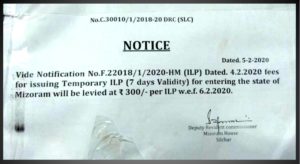NE UpdatesBarak UpdatesBreaking News
Exorbitant hike in ILP rates for entry in Mizoram pose difficulties for people

February 12: Inner Line Permit (ILP) is an official travel document issued to Indian citizens for entry into protected areas. The ILP is required to visit four Northeastern states, namely, Arunachal Pradesh, Mizoram, Manipur and Nagaland.
 An Inner Line Permit, simply put, is a travel document that is required by non-natives to visit these four Northeastern states. The document is essential to allow entry for either travel or work. Both the duration of stay and the areas allowed to be accessed for any non native are determined by the ILP. Different types of permits are issued based on the purpose of a visit.
An Inner Line Permit, simply put, is a travel document that is required by non-natives to visit these four Northeastern states. The document is essential to allow entry for either travel or work. Both the duration of stay and the areas allowed to be accessed for any non native are determined by the ILP. Different types of permits are issued based on the purpose of a visit.
 Initially, the ILP charges for entering the state of Mizoram was Rs.20, which was later increased to Rs.100 per person. From Rs.100, the charges were increased to Rs.120. However, all of a sudden, there has been an exorbitant hike in ILP charges by the state government of Mizoram. At present, for securing a temporary ILP for entry into Mizoram, one needs to pay a charge of Rs.300 per person, which has got a validity of only 7 days.
Initially, the ILP charges for entering the state of Mizoram was Rs.20, which was later increased to Rs.100 per person. From Rs.100, the charges were increased to Rs.120. However, all of a sudden, there has been an exorbitant hike in ILP charges by the state government of Mizoram. At present, for securing a temporary ILP for entry into Mizoram, one needs to pay a charge of Rs.300 per person, which has got a validity of only 7 days.
 On 5 February, 2020, the Deputy Resident Commissioner of Mizoram House in Silchar issued a notice, wherein it was stated, “Vide Notification No.F.22018/1/2020 – HM (ILP), dated 04.02.2020, fees for issuing Temporary ILP (7 days validity) for entering the state of Mizoram will be levied at Rs.300 per ILP with effect from 06.02.2020.”
On 5 February, 2020, the Deputy Resident Commissioner of Mizoram House in Silchar issued a notice, wherein it was stated, “Vide Notification No.F.22018/1/2020 – HM (ILP), dated 04.02.2020, fees for issuing Temporary ILP (7 days validity) for entering the state of Mizoram will be levied at Rs.300 per ILP with effect from 06.02.2020.”
 This steep rise in ILP charges has become a great difficulty for people travelling to Mizoram, especially the labourers, mechanics and such other persons who go there as daily wage earners. One such person, who works as a mason said, “Earlier it was Rs.120, but now we have to pay Rs.300. We also require to give 4 passport size photos and photocopy of relevant documents. All total, for a temporary ILP, we now require to spend around Rs.350. Sometime due to the nature of our work, we need to travel even thrice with gap in between. That means, in a month, we need to spend around Rs.1000 for ILP. We poor people who are daily wage earners find it very difficult to spend such a hefty amount.”
This steep rise in ILP charges has become a great difficulty for people travelling to Mizoram, especially the labourers, mechanics and such other persons who go there as daily wage earners. One such person, who works as a mason said, “Earlier it was Rs.120, but now we have to pay Rs.300. We also require to give 4 passport size photos and photocopy of relevant documents. All total, for a temporary ILP, we now require to spend around Rs.350. Sometime due to the nature of our work, we need to travel even thrice with gap in between. That means, in a month, we need to spend around Rs.1000 for ILP. We poor people who are daily wage earners find it very difficult to spend such a hefty amount.”
 Even those working in sales too find the revised rate of ILP to be an injustice. A youth working with a pharma company said, “Almost around 500 sales people require to visit Mizoram twice or thrice in a month. It is indeed very disappointing for us to pay such a big amount every time we visit. The Mizoram government has made the ILP a source of earning profit. I fervently appeal to our Government in Assam to take up the matter with Mizoram so that the ILP charges could be brought down.”
Even those working in sales too find the revised rate of ILP to be an injustice. A youth working with a pharma company said, “Almost around 500 sales people require to visit Mizoram twice or thrice in a month. It is indeed very disappointing for us to pay such a big amount every time we visit. The Mizoram government has made the ILP a source of earning profit. I fervently appeal to our Government in Assam to take up the matter with Mizoram so that the ILP charges could be brought down.”
 An electrician working as transformer mechanics alleged, “For entering Manipur, one needs to pay only Rs.100 for ILP and that too it remains valid for 15 days. In Arunachal Pradesh & Nagaland, the ILP charge is quite less that that is there in Mizoram. We would request our MP and MLA from Silchar to raise this issue at the appropriate level so that the ILP charges for entering Mizoram is lowered.”
An electrician working as transformer mechanics alleged, “For entering Manipur, one needs to pay only Rs.100 for ILP and that too it remains valid for 15 days. In Arunachal Pradesh & Nagaland, the ILP charge is quite less that that is there in Mizoram. We would request our MP and MLA from Silchar to raise this issue at the appropriate level so that the ILP charges for entering Mizoram is lowered.”
 Inner Line Pass is required for entry into Mizoram and can be obtained from Liaison Officer, Government of Mizoram from the following cities- Kolkata, Silchar, Shillong, Guwahati and New Delhi. Government employees travelling for official purposes are exempted from obtaining ILP but are required to carry a photo identification card with them at all times. Meanwhile, Mizoram home minister Lalchamliana in December 2019 has launched the online Inner Line Permit (ILP) portal, a first of its kind project initiated by the state home department and information and communication technology department.
Inner Line Pass is required for entry into Mizoram and can be obtained from Liaison Officer, Government of Mizoram from the following cities- Kolkata, Silchar, Shillong, Guwahati and New Delhi. Government employees travelling for official purposes are exempted from obtaining ILP but are required to carry a photo identification card with them at all times. Meanwhile, Mizoram home minister Lalchamliana in December 2019 has launched the online Inner Line Permit (ILP) portal, a first of its kind project initiated by the state home department and information and communication technology department.
 The Inner Line Permit is an extension of the Bengal Eastern Frontier Regulation Act 1873. The Britishers framed regulations restricting entry in certain designated areas. This was done to protect the Crown’s interest in certain states by preventing “British subjects” (Indians) from trading within these regions. In 1950, the term ‘British subjects’ was replaced with ‘Citizens of India’. Today, all non natives require the permit. This was done to protect the indigenous tribal communities of these states from exploitation.
The Inner Line Permit is an extension of the Bengal Eastern Frontier Regulation Act 1873. The Britishers framed regulations restricting entry in certain designated areas. This was done to protect the Crown’s interest in certain states by preventing “British subjects” (Indians) from trading within these regions. In 1950, the term ‘British subjects’ was replaced with ‘Citizens of India’. Today, all non natives require the permit. This was done to protect the indigenous tribal communities of these states from exploitation.




